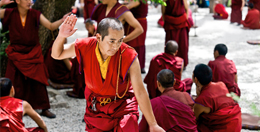Tibetan Funeral & Burial Ritual
The Tibetan funeral customs have been greatly influenced by Tibetan Buddhism and Bon Religion. Generally, funeral rituals practiced in Tibet are stupa burial, sky burial(celestial burial), fire burial (cremation ), water burial, earth burial and tree burial. The funeral services must follow the rigid hierarchy of ranks, sharp demarcation. Which service should be taken also mainly depends on the divination from Lama.
Stupa Burial
Stupa burial is the most noble and sacred funeral ritual in Tibet. It is reserved for Dalai Lama, Panchen Lama or the Living Buddha. After the nirvana of a high Lama, the embalmed corpse is dehydrated and wrapped with rare medicinal herbs and spices. Gold flakes and saffron are scattered on the body in some cases. Finally, the corpse is moved to the stupa and preserved for worshiping. Stupas can be elaborate or simple. It can be constructed of gold, silver, bronze, wood, or earth. The type of stupa selected is based on the ranking of the Lama.
Fire Burial
Fire burial is considered less noble than stupa burial and is reserved for high monks and aristocrats. The service is to pour butter onto the wood and straw to burn the body into ashes. The ashes will be put in a wood box or an earthen jar, and buried in the earth at home or on the top of a hill or in a piece of pure land. The tomb is like a tower. Another way is to take the ashes to the top of a tall mountain scattering it with the wind or into the river. But the sainted Living Buddha or Lama's ashes usually is put into a small gold or silver tower some together with classical books, joss, musical instrument (used in Buddhist or Taoist mass), and treasures. The tower for worship is usually called mourning tower or mourning bone tower.
Sky Burial
Buddhists believe that sky burial represents their wishes to go to heaven. When a person dies, he or she is bent into a sitting position, with the head against the knees. The body is wrapped in white Tibetan cloth and laid on an earthen platform on the right behind the door. Lamas read the scripture aloud to release the soul from purgatory. The family will choose a lucky day and ask the body carrier to carry the body away to the celestial burial platform. "Su” smoke is burned to attract condors, Lamas chant sutras to redeem the sins of the soul, and a professional celestial burial master deals with the body. Then the condors come, and attempt to eat the body.If the body is eaten, it shows the dead person has no sin and that the soul has gone peacefully to Paradise. If not, the remains of the body will be collected and burnt and the Lamas chant sutras to redeem the sins of the dead. The Tibetans believe that the condors on the mountains around the celestial burial platform are "holy birds" and only eat the human body without attacking any small animals nearby.
This method of dealing with the dead is the most widespread way for commoners in Tibet. This may sound gruesome and horrible to many of us, but sky burial is adopted by almost all Tibetan residents after their deaths. There are many prohibitions. Strangers are not allowed to attend the ceremony. Visitors should respect this custom and keep away from such occasions.
Water Burial
In water burial, the corpse is wrapped with white cloth and disposed into a river. There are two different views towards water burial. In areas where sky burial is the dominant practice, water burial is considered an inferior way to dispose of beggars and those with low social status. In places where vultures are not available for sky burial, water burial is widely adopted by commoners and the ritual follows a strict set of rules, sacredly and solemnly.
Earth Burial
To the Tibetans, earth burial is the inferior form. Only those who suffer from infectious diseases or those killed by robbers or murderers will be buried in this way. Earth burial indicates two meanings: One is to eradicate the spread of murrain. The other is to act as a way of penalizing the dead by putting it into the hell.
Tree Burial
This is a burial for children. It is commonly practiced in Nyingchi, southeast of Tibet. To avoid being seen by other children, the corpse of the child is placed in a wooden case and hung on a tree in a remote forest.

.jpg)













